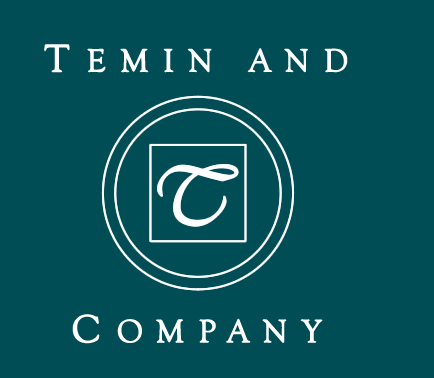“Reputation Matters” White Papers
“Realize that everything connects to everything else.” —Leonardo da Vinci
“Realize that everything connects to everything else.” —Leonardo da Vinci Temin and Company’s “Reputation Matters” White Papers seek to offer deeper insight on a wide range of topics we help clients address, from marketing and social media strategy, to how best to prepare for a crisis before it happens, to handling a crisis once it has occurred. We hope you find these pieces proactive and helpful, and would appreciate your feedback.
“It’s Not over Until It’s over: The Perils Of Declaring Victory In Crisis Too soon” —
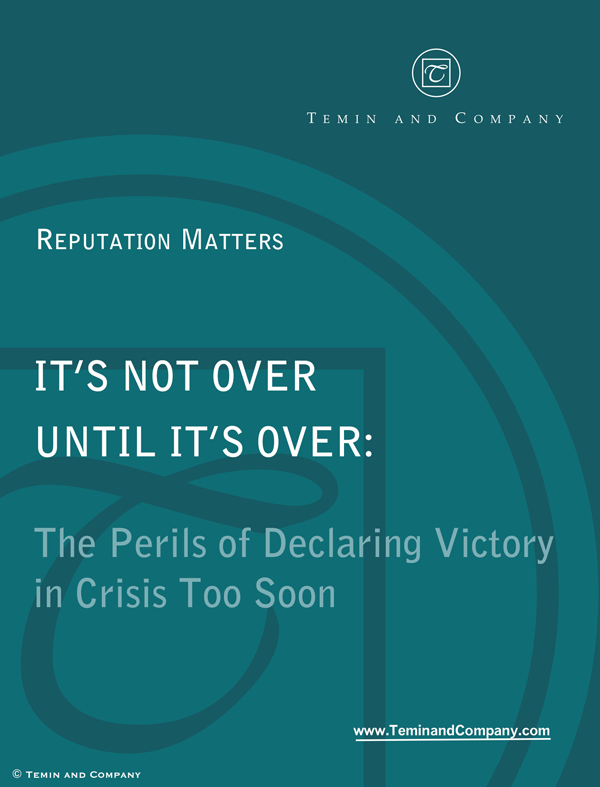 Covid Crisis Rule #7: It is not over just because you want it to be.
Covid Crisis Rule #7: It is not over just because you want it to be.
Do you remember that ill-starred speech in the middle of the Iraq War, when President George Bush stood on the aircraft carrier uss Abraham Lincoln, with a banner hung behind him that announced ~Mission Accomplished~?
Of course, the mission had not been accomplished. In fact, guerrilla warfare escalated and the vast majority of casualties in the Iraq war occurred after the speech had already been given. The whole affair turned into a huge embarrassment that President Bush later called one of the bigger mistakes of his carrer.
It turned into a global symbol of the triumph of wishful thinking over the truth.
But the President wanted the war to be over; everyone did. There were indications that it was winding down. And frankly, the war that started as apparent revenge for 9/11 had become such a polit1cal hot potato that he needed It to be over. The ambiguity was simply insupportable politically and practically, and so everyone jumped on a lie as If It were a lifeline.
Sound familiar?
Of course, we are in the middle of making another such mistake, and it is a classic crisis management mistake that can hurt us even more: This pandemic ls not over, and we pretend It is at our peril.
“Chaos Leadership: When Does Global Crisis Turn Into Chaos and How Do we survive It?” —
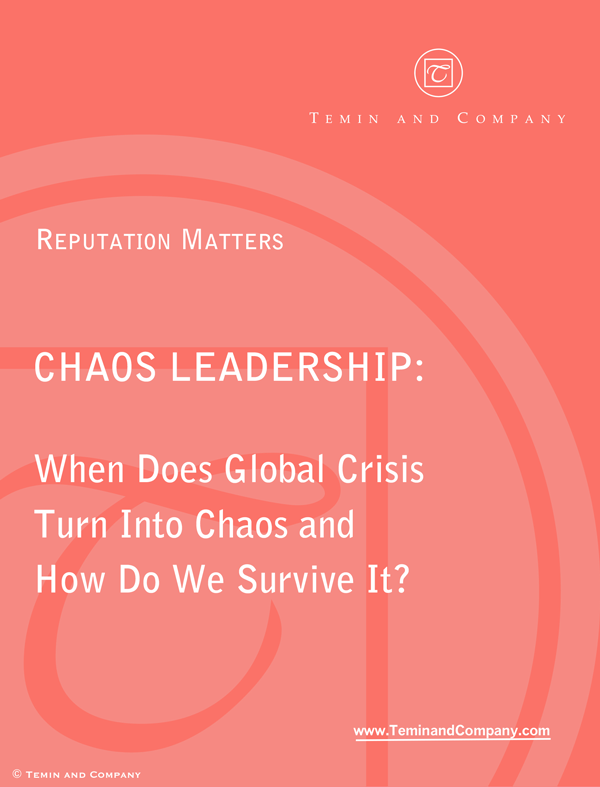 As we balance on the cusp between global crisis and total chaos – and we could make the jump into full-bore chaos at any moment – it is time to explore the difference between the two.
As we balance on the cusp between global crisis and total chaos – and we could make the jump into full-bore chaos at any moment – it is time to explore the difference between the two.
It also is time to talk about how the rules for handling chaos differ substantially from those that govern crisis response.
Because If we cling to crisis management rules In order to address chaos, it will be as Ineffective as If we treat coronavlrus
the same way we treat the common cold.
In chaos, all bets are off, all rules of natural order (except perhaps at the subatomic level) are off too. Compasses fail. Up is
down, down is up, and it’s almost impossible to distinguish between sky and ground. In fact, unlike with crisis, the very
concept of chaos ·management is an oxymoron. By its very nature, chaos can not be managed; it Is ungovernable.
Crisis, on the other hand, even a global crisis such as our COVID-19 pandemic, retains causality, and logic: If you do x, y will probably follow.
“Chaos Rules: 8 Ways to Navigate Through the Fog of Crisis” —
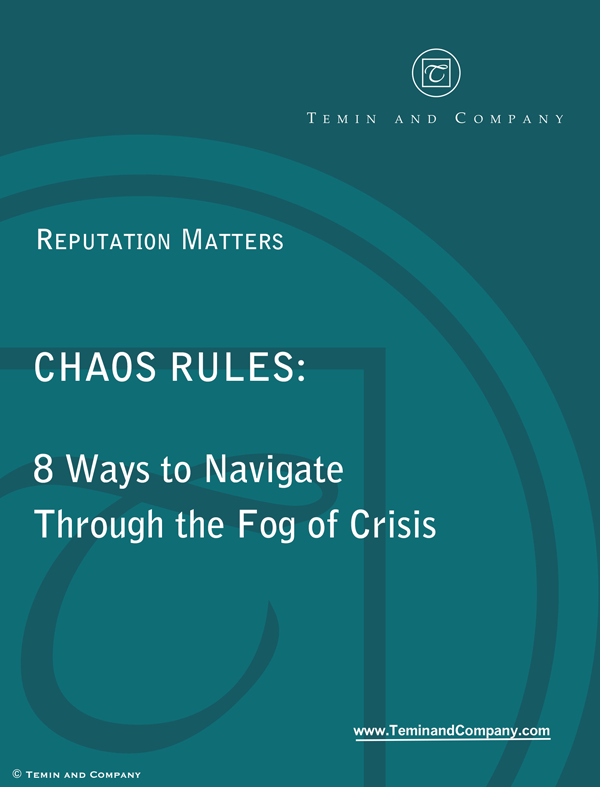 In wartime they call it the fog of war.
In wartime they call it the fog of war.
In crisis Davia Temin calls it the fog of crisis – but what it really amounts to is chaos.
So as we’re surrounded by a deteriorating civic infrastructure and national political response; as our lives and businesses are put on indefinite hold; as working indefinitely from home becomes untenable in many situations and organizations; as family pressures or the pain of Isolation mount when we’re all sequestered at home; as Joblessness careens; as the products we need the most – In hospitals and In our own lives – continue to be unavailable; and as more people get sick and die (this time, who we know) – the result is the fog of the coronavirus crisis.
It’s murky, dense and difficult to navigate. And it probably will exceed most of our abilities to cope
at one time or another.
“Communicating in Crisis: How to Build Trust in an Untrustworthy World” —
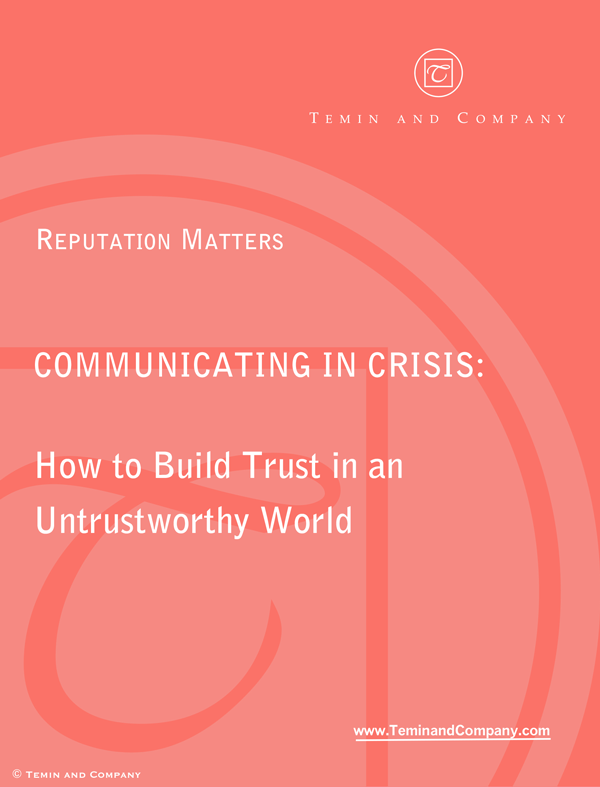 As we enter the first full week of the global pandemic and crashing financial markets, we are all looking for who to listen to, and who to believe.
As we enter the first full week of the global pandemic and crashing financial markets, we are all looking for who to listen to, and who to believe.
We’re looking for a trusted voice in the storm to help guide us, one that can steer us toward the truth as it unfolds, and away from lies and misstatements, be they well-meaning or malicious. This Is the leaders’ task – to provide that “True North” to employees, community, customers, Investors, and stakeholders.
But this is an almost impossible task in such a topsy-turvy landscape, where it can be impossible to distinguish sky from ground.
Sequestered — quarantined by choice or fiat, or simply avoiding exposure by working from home — our choices for who to listen to have changed. No more can we comfortably sit across from our boss in a group meeting and use all of our senses to tell whether he or she is telling us the whole truth. Working remotely, half of the sensors we are used to using are missing.
And while we’re incredibly lucky to have video and teleconferences. podcasts and webinars, live streaming, virtual chat rooms, and virtual galas, salons, board meetings and policy meetings – still that personal touch is missing, and with it many of the clues we use to determine integrity and truthfulness.
So who do we trust? And how can leaders establish trust?
“Crisis Leadership in Real Time: 8 Pandemic Best Practices” —
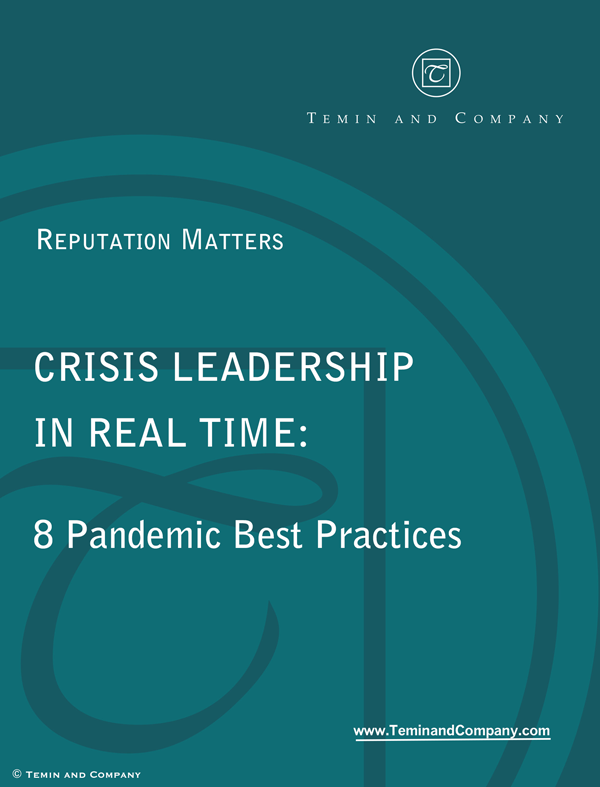 So, it’s here. We now have a pandemic crisis in front of us that is disrupting global markets, businesses, and every sector of our lives, and will, we are promised, do much more damage over an indeterminate amount of time. Life, as we have known it, is changing.
So, it’s here. We now have a pandemic crisis in front of us that is disrupting global markets, businesses, and every sector of our lives, and will, we are promised, do much more damage over an indeterminate amount of time. Life, as we have known it, is changing.
So much ts not In our control, It Is mindboggling to try to figure out what is and what Is not open to our agency. Yet a fundamental rule of crisis management is to exercise as much control as possible over events that unfold – using every tool available to us to bring about a positive outcome.
In fact, how we respond to the COVID19 crisis says more about who we are, and how we lead, than it does about the crisis itself.
So, it’s probably a good time to begin recasting more generic crisis management rules into a specific set of rules for our ament challenge. Now that the current Coronavirus crisis is officially a pandemic, we surely need to develop ever more advanced thinking on how to deal with it.
In this white paper is a new set of 8 pandemic ‘best practices,’ for your consideration.
Great Crisis Management Is Counterintuitive: That’s Why Boeing, Wells Fargo Are Getting It so Wrong” —
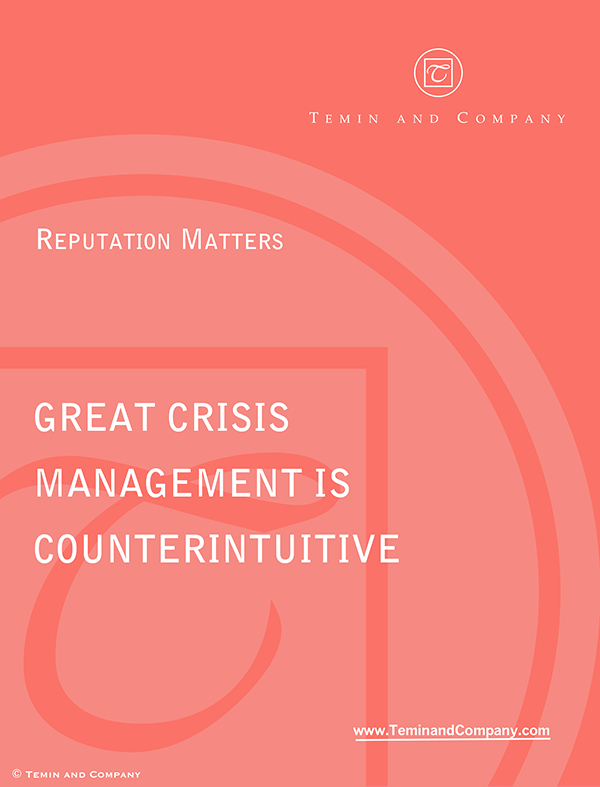 It’s easy to be a Monday morning quarterback, especially for huge companies facing huge problems. But too many companies, like Wells Fargo and Boeing, are getting it all wrong time and time again.
It’s easy to be a Monday morning quarterback, especially for huge companies facing huge problems. But too many companies, like Wells Fargo and Boeing, are getting it all wrong time and time again.
The stakes for their failure – doing the wrong things in crisis and not understanding why – are too high. And consumers, investors, partners, and stakeholders are suffering the consequences. Why the blind spots? Why the inability to get it right when crisis hits?
The core reason that so many big companies, who should know better, fail in crisis is because the best crisis management is counterintuitive, sometimes even illogical, and they absolutely do not understand that.
So they listen to the wrong people, consider only partially the impact and ramifications of their actions, ignore emotion or the zeitgeist of the moment, reflexively make the wrong decisions, dig themselves into holes, and then are loathe or incapable of digging themselves out again.
“Forget the Hype: What Every Business leader Needs to Know About Artificial Intelligence Now” —
 Artificial Intelligence – It’s on the lips of the leaders, and on the 2018 agendas of the board meetings, of almost every global company today. Directors and operating executives alike know, or think they know, that this “new electricity” is going to be the next transformative force of our world. To ignore it now could be fatal to their long-term competitive position, not to mention survival.
Artificial Intelligence – It’s on the lips of the leaders, and on the 2018 agendas of the board meetings, of almost every global company today. Directors and operating executives alike know, or think they know, that this “new electricity” is going to be the next transformative force of our world. To ignore it now could be fatal to their long-term competitive position, not to mention survival.
AI-powered companies that know what they are doing – primarily born in the Internet and mobile eras – have not only gained tremendous advantage In Improved efficiency and Increased profitability, they have literally changed the competitive landscape of successive industries. And they are continuing to do so, as they venture into new fields, challenging a whole new set of incumbents that are not Al “natives.”
Yet, the hype – and pressure to adopt – have gotten extreme, just as the supply of human expertise has become limited. The top 8 technology companies -Google, Facebook, Microsoft, Amazon, IBM, Baidu, Tencent, and Alibaba – light years beyond others in AI adoption and Implementation, are cornering the available talent In the Industry through direct lines of recruitment at the world’s top universities, and by acquiring a steady stream of young, forward-looking start-ups.
So, while it is all well and good for leaders to know that they must get into the game, to not miss the momentum and remain competitive, tremendous time and money are also being wasted through ill-advised, or non-strategic, forays into Al.
“Getting Intelligent About Artificial Intelligence: 6 Ways Executives Can Start” —
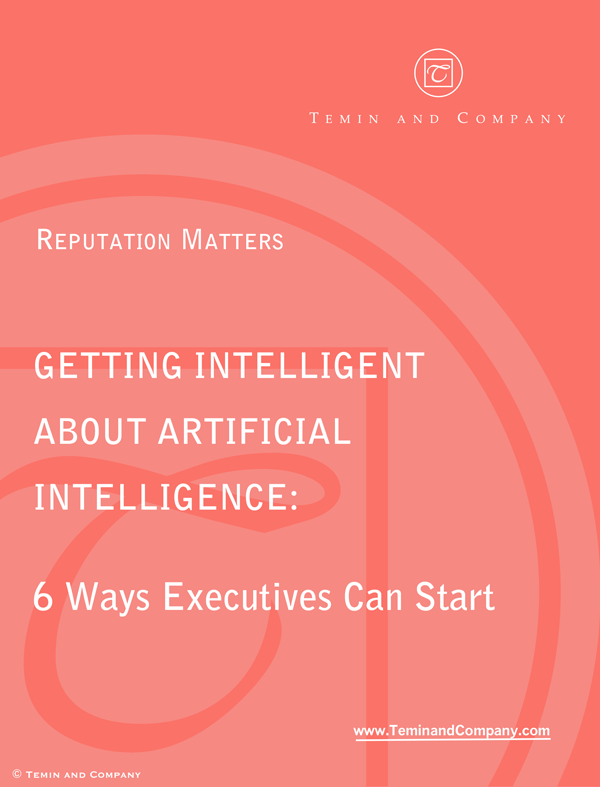 Fortune Magazine asked all the CEOs of the fortune 500 what they believe the biggest challenge facing their companies was. Their biggest concern for 2017: “The rapid pace of technological change” said 73% of those polled, up from 64% In 2016. Cyber security came in only a far second, at 61%, even after all the mega hacks of the past year.
Fortune Magazine asked all the CEOs of the fortune 500 what they believe the biggest challenge facing their companies was. Their biggest concern for 2017: “The rapid pace of technological change” said 73% of those polled, up from 64% In 2016. Cyber security came in only a far second, at 61%, even after all the mega hacks of the past year.
So, what does “technological change” entail? For almost all Fortune 500 CEOs, it means, in part, artificial intelligence. And, as we wrote in ·Forget The Hype: What Every Business leader Needs To Know About Artificial Intelligence Now; Al is on the lips of almost every global CEO and Board of Directors.
But apart from the Big 8 technology companies – Google, Facebook, Microsoft, Amazon, IBM, Baidu, Tencent, and Alibaba – business leaders, especially of earlier generations, may feel they don’t know enough about AI to make informed decisions.
We made a series of 6 suggestions of how board members and c-suite executives can begin to understand this brave new world of Al, Machine Learning, and Deep Learning. And, after being asked by a number of people to break that list out for them, we include It, slightly modified, here.
“How the Reputation Risk of #MeToo is Forcing Businesses to Reevaluate Their Corporate Culture” —
 Real #MeToo incidents in the workplace aren’t happening in a vacuum. Whether they are the most egregious examples of sexual harassment and abuse, or more subtle acts of unconscious bias, they all happen within a culture that somehow sanctions them.
Real #MeToo incidents in the workplace aren’t happening in a vacuum. Whether they are the most egregious examples of sexual harassment and abuse, or more subtle acts of unconscious bias, they all happen within a culture that somehow sanctions them.
That is why the reputational risks of #MeToo (we calculate that since the first Bill Cosby trial, over 670 high-profile public figures have been accused of sexual improprieties), as well as escalating global calls for gender equity, are sparking a whole new examination of corporate and organizational culture.
What elements of culture enable abuse, or create a toxic work environment, and what elements preclude them?
“Reputation Agenda for Directors: A 20-Point Plan for Boards to Address Reputational Risk” —
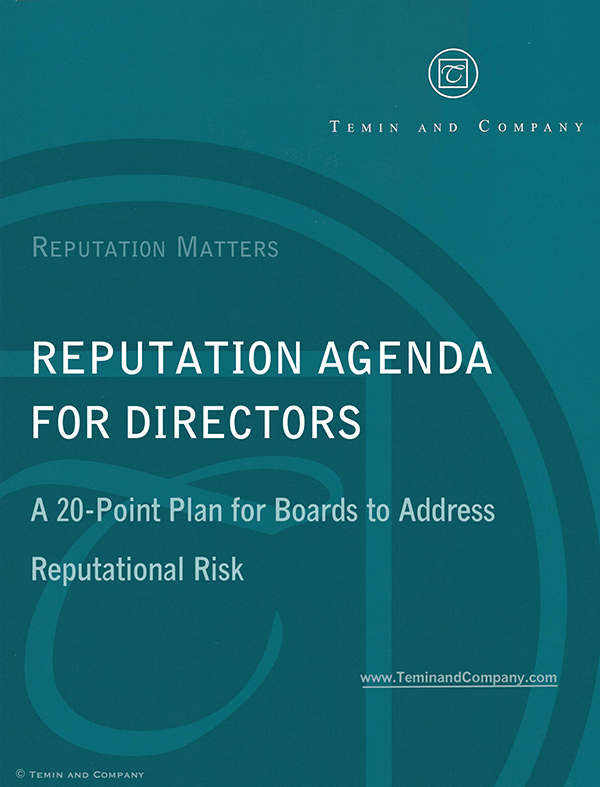 Reputation is a hard concept to circle, especially at the governance level.
Reputation is a hard concept to circle, especially at the governance level.
Some try to quantify it by share price, business process metrics, or a complex algorithm of risk factors. Others equate it directly to brand equity. Still others, to fulfilling a social contract of trust with the public. And on Wall Street trading floors, traders will often yell out, at the beginning of a trade, “What kind of a name does it have?” as a way of encapsulating a company’s gestalt – the conventional wisdom of just how investible it is.
But no matter how you define it, corporate reputation has become one of the biggest, albeit intangible, assets or liabilities a company has, and thus an important consideration for the board of directors.
Customers buy; new employees join; vendors extend credit; shareholders are influenced; potential partners commit; referrers recommend; goodwill is extended in crisis; legislators demand testimony; and regulators pounce on an organization, its products and services, based upon its reputation.
Even Alan Greenspan has been quoted as saying that “In a market system based on trust, reputation has a significant economic value.”
Or, as Warren Buffet has said – “It takes 20 years to build a reputation and five minutes to ruin it. If you think about that, you’ll do things differently.”
So, how should corporate board members “think about” it? How should they monitor, assess and govern corporate reputation? Even more, how do corporate boards create their companies’ reputation?
We would like to submit that corporate boards are indeed an important engine of reputation, not just its monitors.
“A 15-Point Plan for Boards and CEOs to Eradicate Sexual Harassment in Their Organizations” —
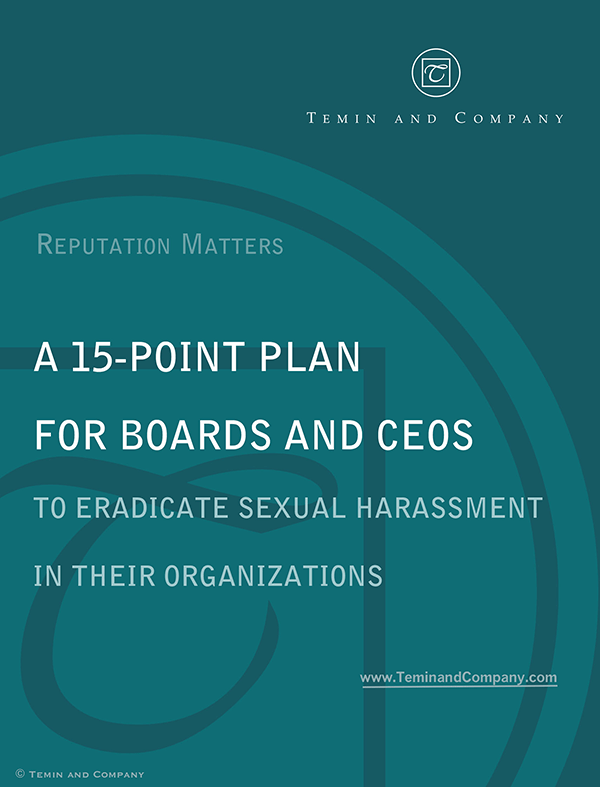 As organizations wait for the next wave in the tsunami of sexual abuse charges that is rocking American business, board directors and C-suite executives are fixated not only on understanding their risk exposure, but on what they can do to get ahead of the issue.
As organizations wait for the next wave in the tsunami of sexual abuse charges that is rocking American business, board directors and C-suite executives are fixated not only on understanding their risk exposure, but on what they can do to get ahead of the issue.
Decades of sexual misbehavior in the workplace are coming to the fore with fearsome velocity. No organization can feel immune, as long-buried cases are being revived alongside current ones. And while corporate directors and CEOs, as well as nonprofit and education leaders, may be hoping for absolution, or that the waves will miss them, deep down they fear they will not.
The only solution – and the right solution of course – is for leaders of all stripes to seriously take up the challenge of quashing sexual harassment in their workplaces for good.
“What They’re Saying About You When You’re Not In The Room — And What You Can Do To Influence It” —
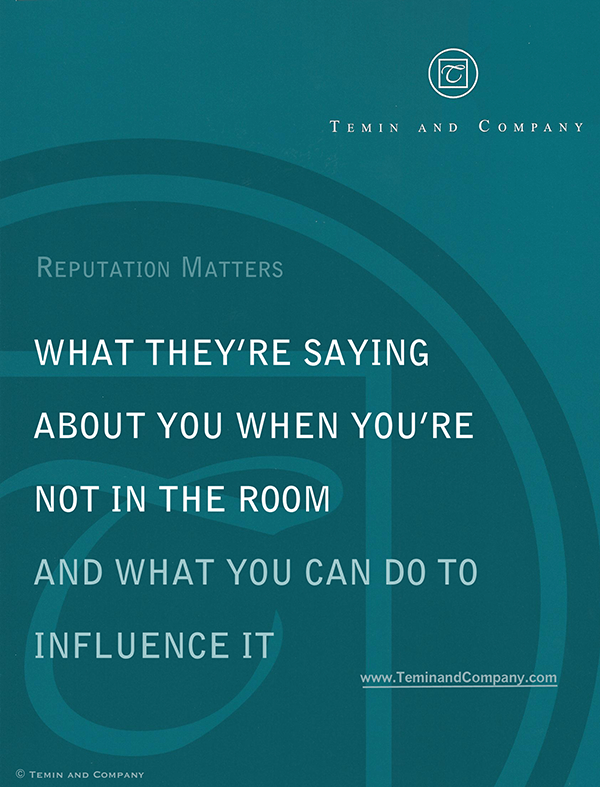 The biggest decisions about your career are often made when you’re not in the room.
The biggest decisions about your career are often made when you’re not in the room.
Whether it’s a decision about if you’ll be hired, promoted or fired; whether you are put forth by a headhunter to a selection committee and then asked to join a corporate board or become a university trustee; whether you make managing director or are passed over; are awarded tenure; or offered the CEO slot, your professional fate is often determined in closed rooms where people are talking about – and evaluating – you, without the benefit of your input.
When you are not in the room, discussions most often center around performance, potential, leadership ability, flaws and the all-important, if fuzzy, concept of “fit.”
While each talent review or selection committee may look for slightly different attributes, these discussions include at least five different kinds of input: 1) Your reputation; 2) Your “presence”; 3) Your track record; 4) The comments of those who support you and those who do not; and 5) The direct impressions you have made on the decision-makers in the room, in interviews, conversations, or other interactions.
But even taking into consideration all of these data points, the decisions are not always logical. So, what else can you do – in the present – to influence how you are evaluated by those in control of your professional career? These eight strategies may help you get others to see you, and judge you, in the ways you would wish.
“You Have 15 Minutes to Respond to a Crisis: A Checklist of Dos and Don’ts” —
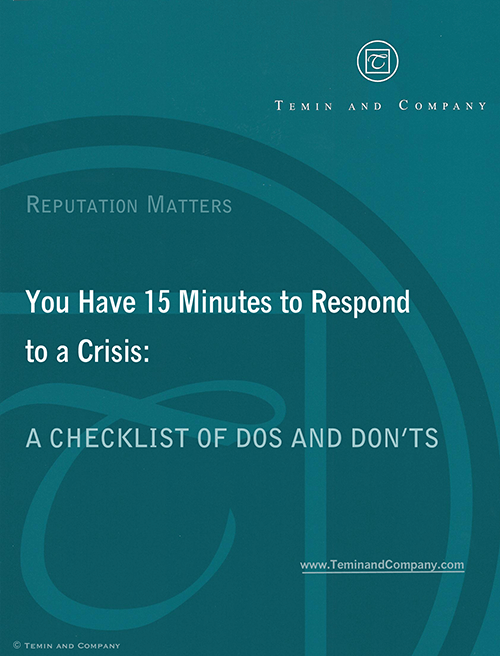 When a crisis hits, how you respond in the first 15 minutes can make or break your organization – and your reputation.
When a crisis hits, how you respond in the first 15 minutes can make or break your organization – and your reputation.
While we all know that crisis management training is critical for leaders and boards today, much of it still tends to be shopworn, focusing on the lessons of yesterday. The new climate of ultra urgency is rarely emphasized sufficiently.
Yet we have found that in those first 15 minutes of a crisis your response must be exactly the right message, delivered in exactly the right words, to the right audiences, in just the right way – or you will have to deal with your mistakes for days, weeks, even months to come.
Immediate response and indelible accountability – that’s a tall order for any leader.
“Cybercrime is Rewriting the Rules of Crisis Management” —
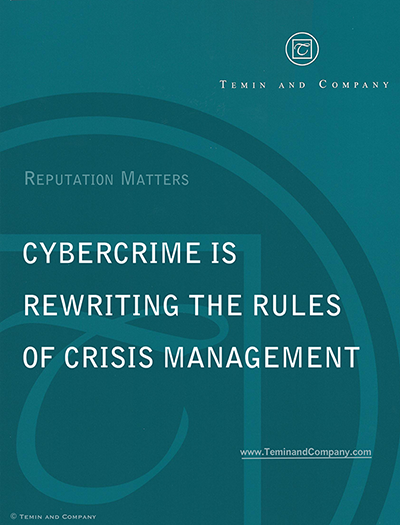 Cybercrime represents a whole new order of magnitude of crisis for every organization and industry around the world. No company large or small, no bank or financial institution, hospital, insurer, university, nonprofit or government is immune.
Cybercrime represents a whole new order of magnitude of crisis for every organization and industry around the world. No company large or small, no bank or financial institution, hospital, insurer, university, nonprofit or government is immune.
Now that cybercrime is such big business, organized crime, global governments, and loose confederations of hacktivists attack organizations relentlessly to take over customers’ identities, finances, smart homes, cars, insurance benefits, tax returns, electrical and water supply, lives.
Stolen data is being sold not only on the dark web, but on YouTube. And everyone knows this is only the beginning. Identity will be compromised in the future in ways that neither the black nor white hats can even imagine today, using stolen retinal scans, fingerprints, fMRIs and, who knows, possibly even brain waves.
Most of the ways organizations have successfully handled crises up until now simply do not work anymore. Cybercrime is literally rewriting the crisis management rule book.
“Resilience: New Research Helps Us Bounce Back Quicker, Better from Life’s Trials and Tragedies” —
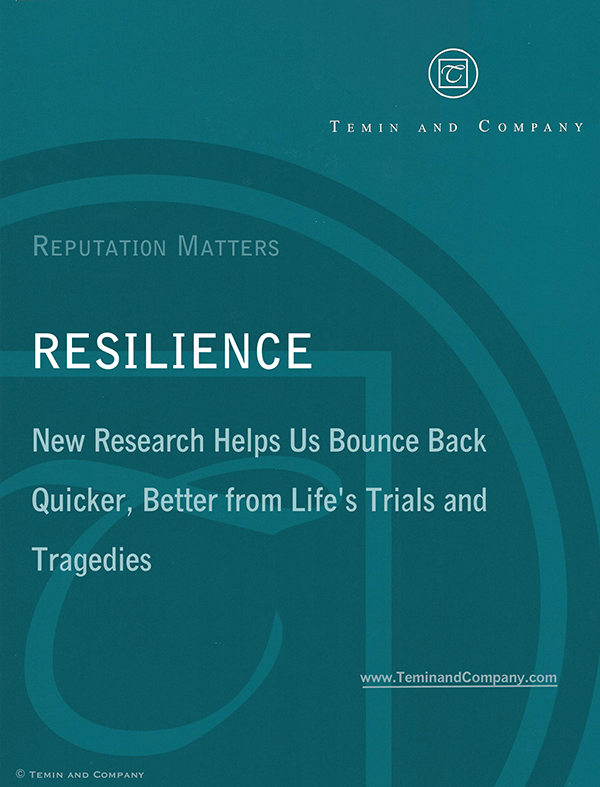 Resilience is a concept that exists in almost every culture around the world: the ability to bounce back from adversity, from whatever setbacks life deals you, in order to come back and conquer another day.
Resilience is a concept that exists in almost every culture around the world: the ability to bounce back from adversity, from whatever setbacks life deals you, in order to come back and conquer another day.
From Ernest Hemingway in A Farewell to Arms: “The world breaks everyone, and afterwards many are strong in the broken places”…
…To the concept of the Refiner’s Fire invoked by author Mark Helprin: being forged by walking through fire, and coming out finer, stronger, better, and more indomitable…
…To the Japanese Daruma doll, a version of the Buddha with no arms or legs, so he can always snap back from setbacks – “Seven times down; eight times up”…
Resilience has been the Holy Grail for those individuals or organizations that have gone through crisis and adversity and want, literally, to “get their lives back.”
But while it has always been known that some people, and some organizations, recover better than others, new brain and behavioral research is now shedding light on why. Even better, it is showing that we can cultivate resilience in ourselves before we even need it.
“Crisis Management in Food Retail” —
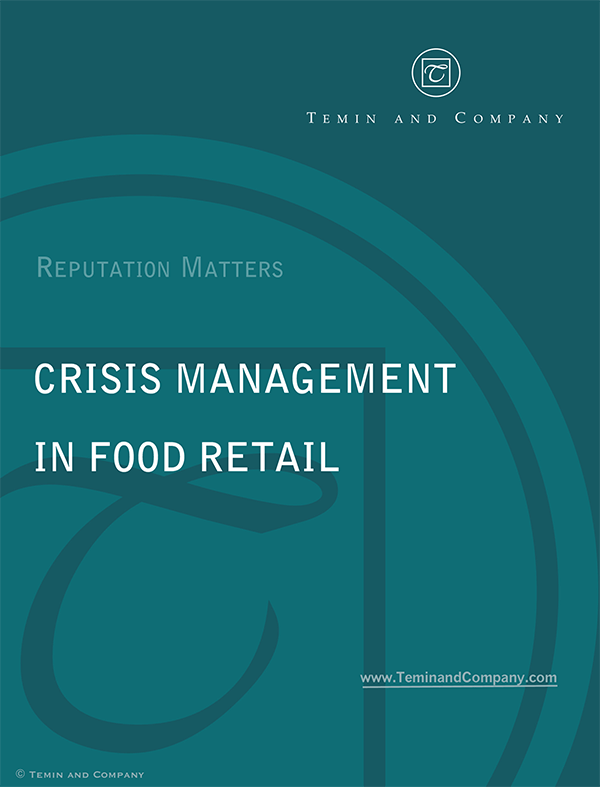 Anticipated or not, when a crisis strikes a company, CEOs must be prepared to respond immediately in order to lead their organizations through a potentially catastrophic event.
Anticipated or not, when a crisis strikes a company, CEOs must be prepared to respond immediately in order to lead their organizations through a potentially catastrophic event.
Within the last five years alone, the food industry has been at risk for a wide spectrum of crises, including E. coli and norovirus outbreaks in fresh food, cybercrime such as hightech SQL injection attacks aimed to steal customer data, natural disasters, and traditional and social media public relations disasters.
While there are certainly aspects of a crisis response that can be planned in advance, each incident inevitably requires a unique approach.
Creating a comprehensive crisis preparation plan, correctly managing the event itself, and recovering in the right way can help to protect your brand as well as your organization.
“Employees Are the Ultimate Co-branding Opportunity On Corporate Social Media: 6 Steps to Forge a Brand Partnership with Your Employees” —
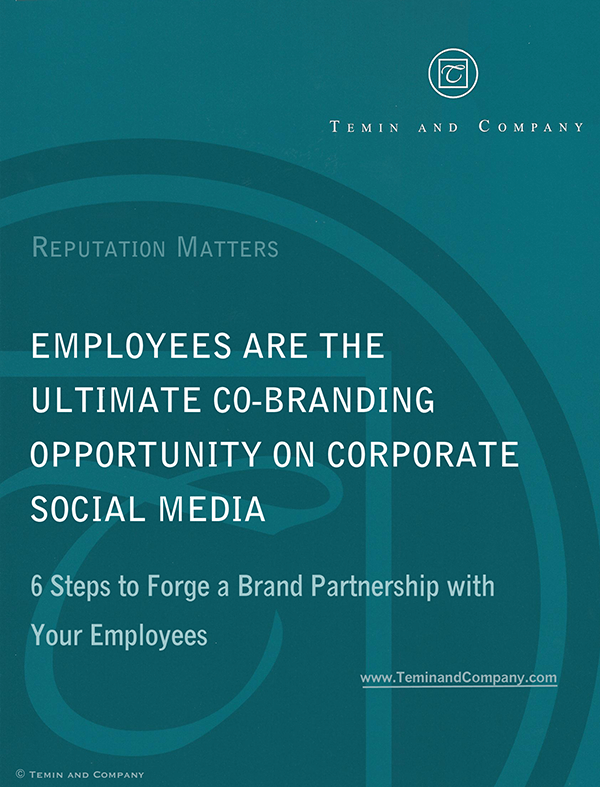 Employees can be both brand ambassadors and brand detractors. They can also be an organization’s most important co-branding
Employees can be both brand ambassadors and brand detractors. They can also be an organization’s most important co-branding
opportunity over corporate social media.
Corporate co-branding and cross-branding have long been marketing staples: companies co-brand with one another; for-profits co-brand with non-profits; and all of the above co-brand with movies, music, and sports.
But, in this ever-evolving world of social media – where almost everyone is thinking about how to “brand” himself or herself personally on the web – organizations can leverage that trend into their biggest co-branding opportunity of all. In other words, since there is no stopping the personal branding efforts of employees on social media, organizations can adapt to thrive.
“Women and Power: Seven Ways Successful Women Survive” —
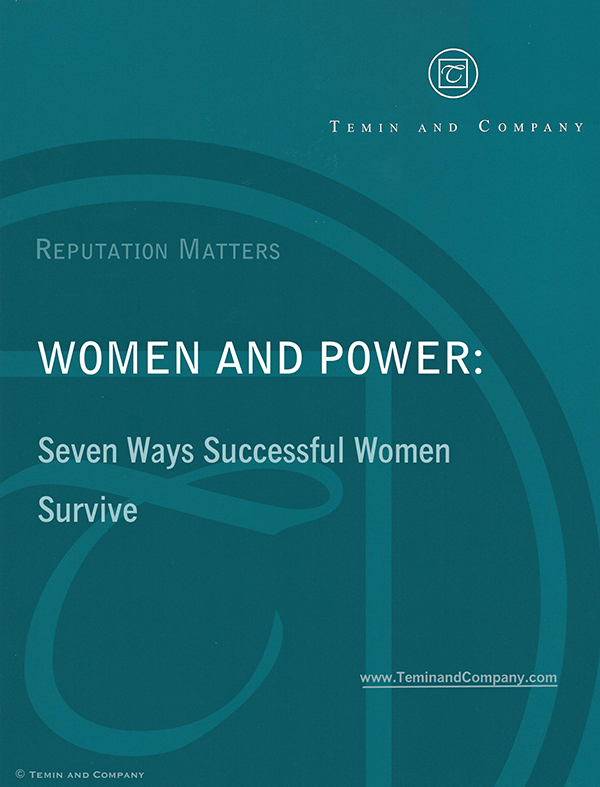 Two steps forward, one step back; one step forward, two steps back: for many women who have ascended the rungs of the financial industry, it seems that our progress has stalled out since 2008, despite making undeniable strides over the prior three decades. Absolute numbers have not moved or have gone backwards, doors continue to revolve, and we seem to be discussing the same issues publicly over and over again, while more compelling issues are left unaddressed.
Two steps forward, one step back; one step forward, two steps back: for many women who have ascended the rungs of the financial industry, it seems that our progress has stalled out since 2008, despite making undeniable strides over the prior three decades. Absolute numbers have not moved or have gone backwards, doors continue to revolve, and we seem to be discussing the same issues publicly over and over again, while more compelling issues are left unaddressed.
But evolving research is shedding new light on power, gender differences regarding the use of power, and how powerful women can succeed in complex organizations.
Some of these insights are not positive or politically correct, but they do help explain gender gaps in finance and other industries.
“College and University Crisis Watchlist” —
 Colleges and universities have come under enormous pressure and scrutiny over the past few years due to issues ranging from campus shootings, to violence against women, to divestment, to race relations, to data breaches. And it doesn’t appear as if these issues will abate any time soon. In fact, it’s likely pressure will continue to mount.
Colleges and universities have come under enormous pressure and scrutiny over the past few years due to issues ranging from campus shootings, to violence against women, to divestment, to race relations, to data breaches. And it doesn’t appear as if these issues will abate any time soon. In fact, it’s likely pressure will continue to mount.
Temin and Company has significant experience with almost every kind of crisis situation in higher education, and we are committed to helping colleges and universities weather the inevitable challenges that come their way.
In order to prepare college and university Presidents, Chancellors, Trustees, and their staffs, we have developed a “College and University Crisis Watchlist” of thirteen of the most volatile issues – both nascent and continuing – on campuses nationwide.
“What Boards Must Know About Social Media” —
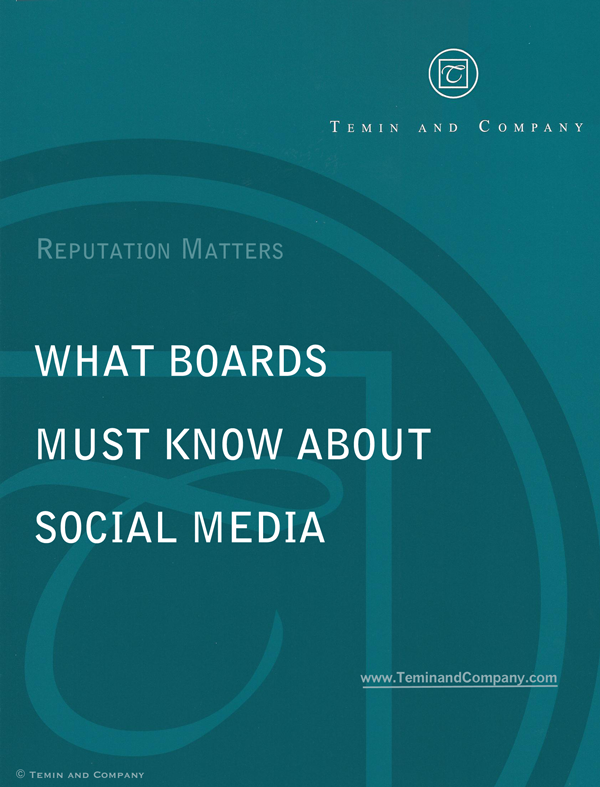 In this age of social media, companies of all kinds find themselves at the end of the “command and control” model of leadership. Top-down communications, including those from the C-suite and the boardroom, have lost their primacy.
In this age of social media, companies of all kinds find themselves at the end of the “command and control” model of leadership. Top-down communications, including those from the C-suite and the boardroom, have lost their primacy.
Today, with blogs, vlogs, podcasts, Twitter, Facebook, YouTube, Tumblr, Instagram, and social media of all kinds, everyone has a voice. More to the point, anyone can move markets if his or her voice catches on with the public.
Employees have a voice—including the employee that management fired yesterday. Your “likers” have a voice; your dislikers have a voice too (including all of the “I hate xx company” websites, and Facebook-facilitated boycotts). Your competitors have a voice, your shareholders have a voice, and you, as board members, have a voice as well. However, amid the cacophony, it is now exponentially more difficult to make the messages you and your company wish to convey heard.
Especially for the board, knowing how to communicate in social media (and when it is or is not appropriate) is crucial.
“The Role of Boards in Crisis: 10 Steps for Directors Before, During and After Crisis” —
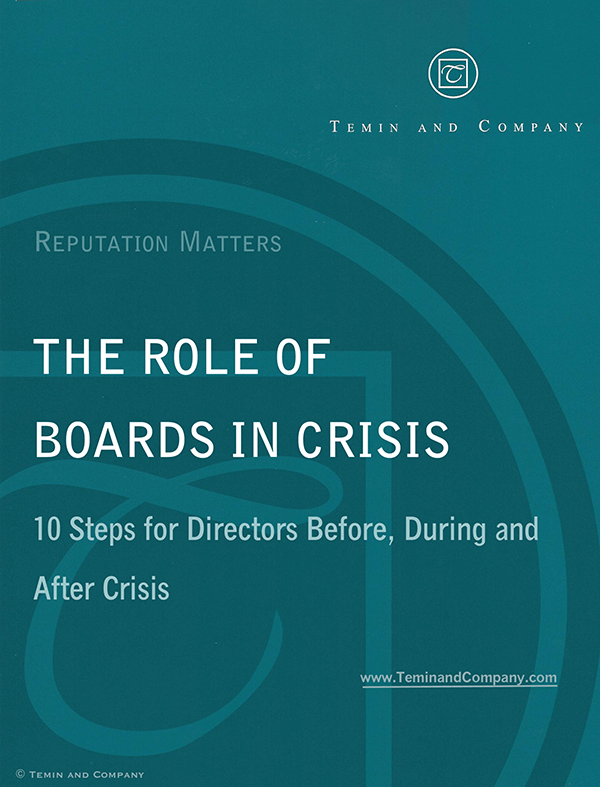 We see it every day in our headlines: as crisis has become a new global norm, the board’s responsibility in crisis is changing rapidly.
We see it every day in our headlines: as crisis has become a new global norm, the board’s responsibility in crisis is changing rapidly.
No longer is plausible deniability acceptable, either for boards or for management. Corporate and nonprofit boards alike are expected to know of problems that are brewing deep within their organizations. And they are expected to act upon that knowledge swiftly.
The public, shareholders, and media are holding boards responsible for corporate missteps as never before, and therefore the role of governance leading up to, during, and after crisis is transforming as we speak.
So, what are boards to do in order to prepare for, possibly prevent, respond to, and recover from the inevitable crises that will befall their institutions? Based on our 25 years’ experience helping almost every kind of board imaginable through crisis, we have compiled a list of 10 steps for directors before, during and after crisis.
“10 Leadership Blind Spots That Can Trigger Business Crises in 2017” —
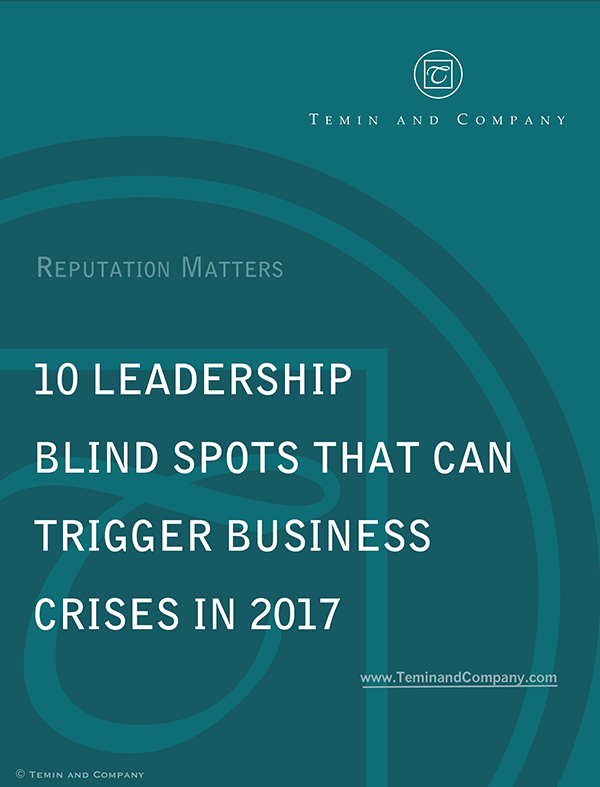 When you look closely at what triggers crises in organizations, you often see that there is a major leadership oversight or blind spot that has allowed the crisis to exist in the first place – and then grow, unrecognized, until it’s too late.
When you look closely at what triggers crises in organizations, you often see that there is a major leadership oversight or blind spot that has allowed the crisis to exist in the first place – and then grow, unrecognized, until it’s too late.
Just as many leaders want to be perceived as trustworthy in a rapidly changing environment, leaders themselves need to be aware of who and what they are trusting. Misplaced trust is a clear precursor to trouble.
As businesses look toward the coming year, we take a deeper dive into common crisis triggers, so that management teams and boards can recognize hidden risks and danger zones within their organizations.
“The 9 Worst Ways to Brand Yourself” —
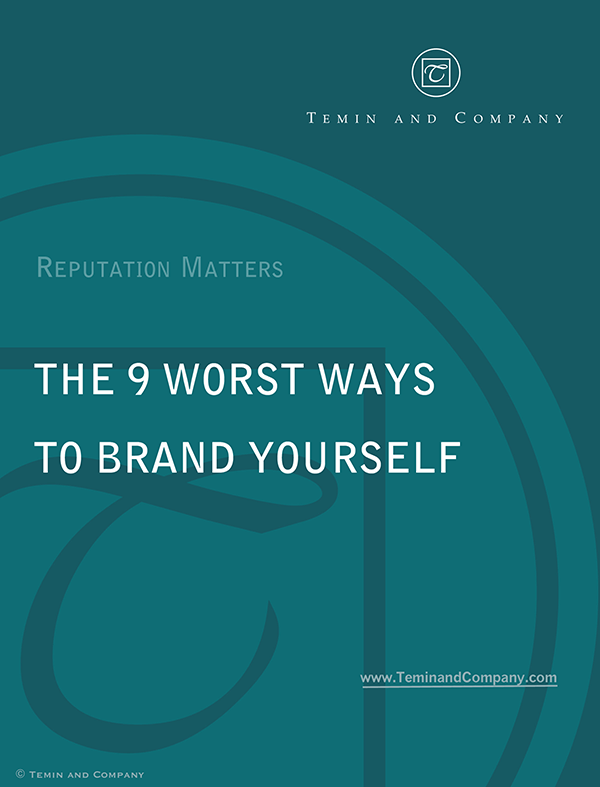 Are you getting tired of all the content-less “content marketing” that pervades the internet in order to “brand” professionals as thought leaders? Most of the HR heads and CEOs we work with are.
Are you getting tired of all the content-less “content marketing” that pervades the internet in order to “brand” professionals as thought leaders? Most of the HR heads and CEOs we work with are.
They see this explosion of self-branding “lite” as insubstantial and overly self-promotional. And while the internet does afford everyone a platform to air their thoughts, when done poorly it can backfire and actually take away from your professional reputation and brand equity, instead of building it up.
True content marketing is leveraging the unique ideas, expertise, opinions, and insight of employees not for the employees’ sake, but to raise the reputation of their organizations.
It is possible for corporate or non-profit professionals to successfully position themselves in public as thought leaders, but not for everyone and not in the wrong ways.
So, to help you avoid some of the pitfalls of over-self-promotion and under-delivery, here is our list of the nine worst ways to brand yourself in 2017.
“Announcing CEO Illness: Best Practices from Buffett to Benmosche” —
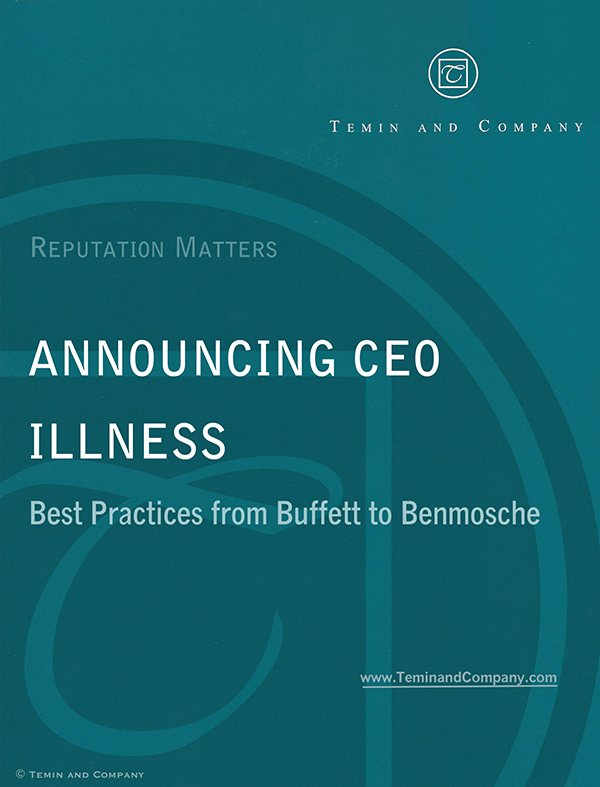 Announcing a CEO’s illness is never easy. All sorts of public and private speculation can follow even the most carefully choreographed announcements. The situation is often complicated by the level of severity of the illness and the personal style of the CEO affected – and exacerbated by the very human fear we all experience in the face of catastrophic illness.
Announcing a CEO’s illness is never easy. All sorts of public and private speculation can follow even the most carefully choreographed announcements. The situation is often complicated by the level of severity of the illness and the personal style of the CEO affected – and exacerbated by the very human fear we all experience in the face of catastrophic illness.
Must a CEO announce his or her health problems immediately? Is the health of the leader of a public company material information? How best should the information be announced, by the board, the CEO him- or herself, the interim CEO, or an institutional message?
The timing and tenor of announcements often are determined by the type of illness or condition; how much of a surprise it was; how badly the CEO is incapacitated; and the feasibility of treatment and recovery.
Companies must strike a complicated balance among issues of transparency, privacy, sensitivity to family requests, and disclosure imperatives when a CEO falls ill.


